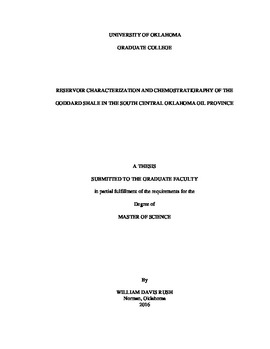| dc.description.abstract | The Goddard Shale of the South Central Oklahoma Oil Province, or SCOOP, has become a formation of interest in recent years. However, there is a paucity of published information in regards to this formation. Therefore, the purpose of this study is to provide a reservoir characterization of the formation by means of core description of lithofacies, chemostratigraphic trends, chemofacies, mineralogy, and porosity. Additionally, this study sets out to define the appropriate nomenclature for the formation, which has not been defined in a formal sense.
Descriptions and chemostratigraphic work were carried out on two cores taken from the formation. One was taken from its uppermost organic-rich bench, which this study refers to as the Boatwright Shale, and the other core was taken from the lowermost organic-rich bench, which this study refers to as the Velma Shale. Both cores are predominantly siliceous-argillaceous with carbonate content being restricted to debris flows from the inner shelf. Each core contains its own parasequence set with higher-order intervals superimposed, most easily defined by the changes in continental input by means of trace elemental proxies, although each has a different manifestation of the effects of rising sea levels.
In analyzing the porosity of the formation, this study compares three different techniques: 1) FESEM image analysis utilizing ion beam milling, 2) FESEM image analysis utilizing freshly broken shale surfaces, and 3) a method that relies upon calculated matrix density based upon Rock-Eval and XRD mineralogy. Of the three, the broken surfaces technique appears to have produced the most accurate results due to the large margin of error in the calculated density technique and the general lack of inorganic porosity in the ion beam milling technique. Measured porosity values range from 7.04% to 13.11%. | en_US |



